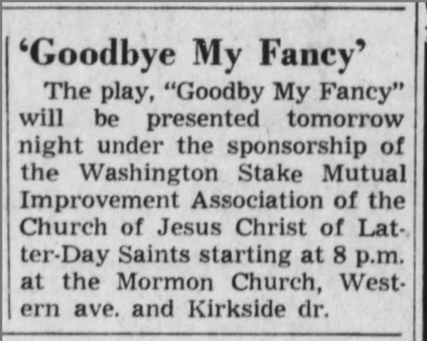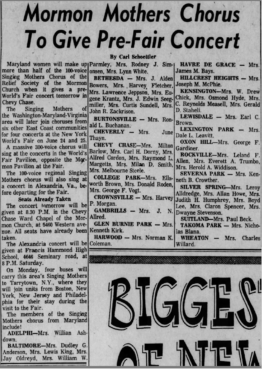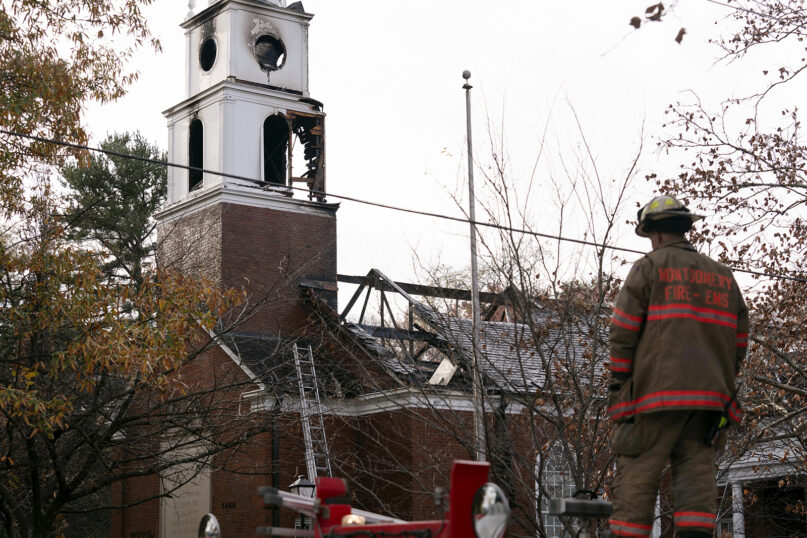(RNS) — On Monday afternoon (Nov. 20), a meetinghouse of The Church of Jesus Christ of Latter-day Saints went up in flames in Chevy Chase, Maryland. I learned about this when two people in my Facebook feed who had fond memories of that chapel posted their sadness and anxiety. According to local CBS news outlet WUSA9, the fire resulted in a partial collapse of the building and required more than 100 firefighters to stop the flames.
Thank heavens, no one was killed or injured. But there has been more than $10 million in damage, and it’s not yet clear whether the building can be restored or will need to be replaced entirely.
The cause of the fire had not been released as of this writing, but none of the news reports mention foul play.
I don’t have any personal history with that chapel, but it dates from the 1950s, the same decade as my own ward’s meetinghouse, so I’ve been thinking of how devastated I would feel if something similar happened here. There’s so much history in these buildings, affecting so many lives. I know that in terms of history, a church that is 70-something years old has nothing on a church that is, say, 700. But in Mormonism, so much of daily life has happened in these buildings — especially back then. The Chevy Chase building, and my own ward building, have hosted remarkable efforts at forging community.
The 1950s marked a unique historical moment in the growth of the church, particularly in the Washington, D.C., area. Those were heady days. Ezra Taft Benson was taking his spot as President Dwight D. Eisenhower’s secretary of agriculture, the highest post ever held by a Mormon in national life. Just about anything seemed possible for our young religion on the move. In terms of the media and its public image, the church was enjoying a kind of golden era between the anti-polygamy coverage of the late 19th and very early 20th centuries and the critical treatments of the church’s handling of race and gender — criticism that began in the 1960s and really has not stopped.
Both the Chevy Chase building and my own ward’s building were constructed very differently from how the church does things today. Before the Correlation program took hold in the late 1970s and 1980s, members had to raise their own money to construct their local buildings. This resulted in a lot of architectural variety that many of us mourn the loss of now. When the church took over, the good news was that local wards didn’t have to engage in massive fundraising efforts (on top of tithing) to erect their chapels, a welcome change that made having a chapel building just as possible for a poor community as for an affluent one like Chevy Chase. The bad news was that it instituted a somewhat soulless process of cookie-cutter meetinghouse plans that could be plopped down anywhere in the world and erected quickly. Efficiency, not beauty, was the rule.
Pre-Correlation midcentury LDS buildings sometimes came with extras that reflected the tenor of the times, facilitating the many “extracurricular” activities that were part and parcel of Mormon life. This vanished social world is something that many older members of the church express great nostalgia for, and it comes through in a brief newspaper search of the early years of the Chevy Chase ward.
 In 1962, for example, the building made the news for hosting the theatrical “Goodbye My Fancy,” put on by the youth of the Washington Stake Mutual Improvement Association (later called “Young Men” and “Young Women”). This was no amateur road show, but an ambitious stage production based on a 1948 Broadway play and 1951 Joan Crawford movie. All done with volunteer talent.
In 1962, for example, the building made the news for hosting the theatrical “Goodbye My Fancy,” put on by the youth of the Washington Stake Mutual Improvement Association (later called “Young Men” and “Young Women”). This was no amateur road show, but an ambitious stage production based on a 1948 Broadway play and 1951 Joan Crawford movie. All done with volunteer talent.
The following year, the Chevy Chase ward again made the news, this time for its success in the church’s flourishing basketball league for high school boys, which at that time included teams from 4,000 wards across the United States. Chevy Chase won its region, beating teams across the Eastern Seaboard from Maine to North Carolina. Then it sent its undefeated team to the national championships in Salt Lake City. Writing of the team’s chances, the local Montgomery County Sentinel boasted that the church’s athletic program was “probably the world’s largest basketball league.” I doubt that, but it’s undeniable that the league’s scope was massive and that it cemented many people’s ties to the church during the week as well as on Sundays. (It also affected the cookie-cutter architecture of local meetinghouses henceforth: Even though we don’t have basketball tournaments now, the larger plans still very much feature basketball courts.)
One more news clipping about the Chevy Chase ward, this time from the following year, 1964. The Baltimore Sun reported on the Singing Mormon Mothers, who headed to New York City to participate in a major musical extravaganza. They gave a preview concert at the Chevy Chase meetinghouse before joining hundreds of other Singing Mothers who would perform opposite the Mormon Pavilion at the 1964 World’s Fair. (Other groups of Singing Mormon Mothers were organized in America and Europe from the 1920s through the 1970s, it seems, and were sometimes called the Relief Society Singing Mothers.)
 All three of these activities have disappeared from ward life. We don’t put on Broadway plays (or even road shows) anymore, participate in a national basketball league involving thousands of church teams or send hundreds of local singers to perform at a World’s Fair. Nor have we replaced that vibrant social world with anything new, at least for adults.
All three of these activities have disappeared from ward life. We don’t put on Broadway plays (or even road shows) anymore, participate in a national basketball league involving thousands of church teams or send hundreds of local singers to perform at a World’s Fair. Nor have we replaced that vibrant social world with anything new, at least for adults.
Granted, people are busy: More women work, and kids have greater academic demands today (homework for kindergartners?!). Community-building is time-consuming. In its slow erosion, though, the church has lost some of its vitality. Today, LDS adults have Sunday church, monthly temple nights and self-directed gospel instruction at home, punctuated by the occasional, and very welcome, potluck or holiday celebration.
If the Chevy Chase building has to be replaced, I hope it’s done with respect not just for the ward’s religious life and sacrament meetings but also for its secret sauce of community. I hope they keep not just a basketball court but also a stage. Is it practical? No. Optimistic? Yes.
Latter-day Saints used to be geniuses at creating community, in all kinds of creative ways. And judging from the atomization of society and growing loneliness of people around the world, that’s going to be needed now more than ever.






